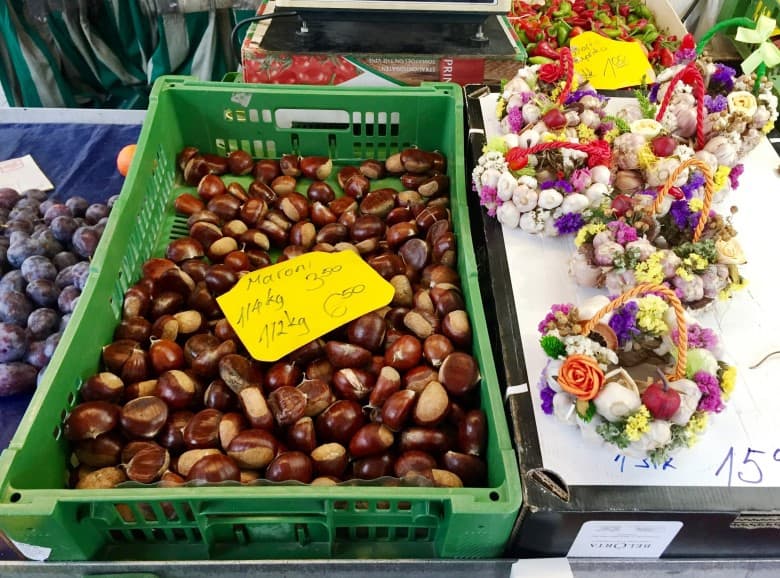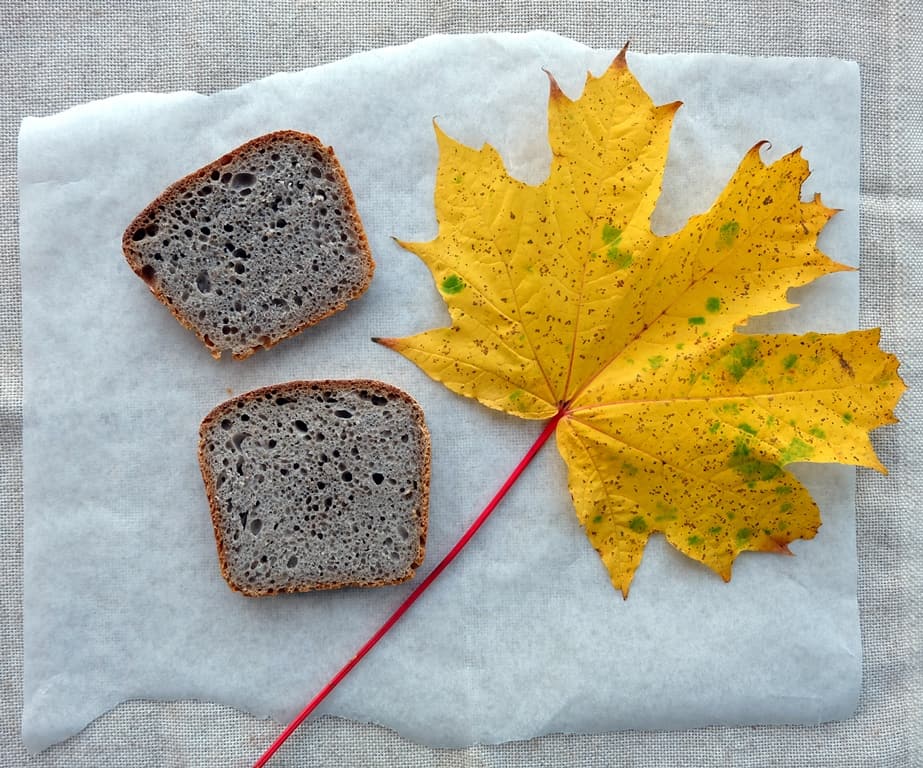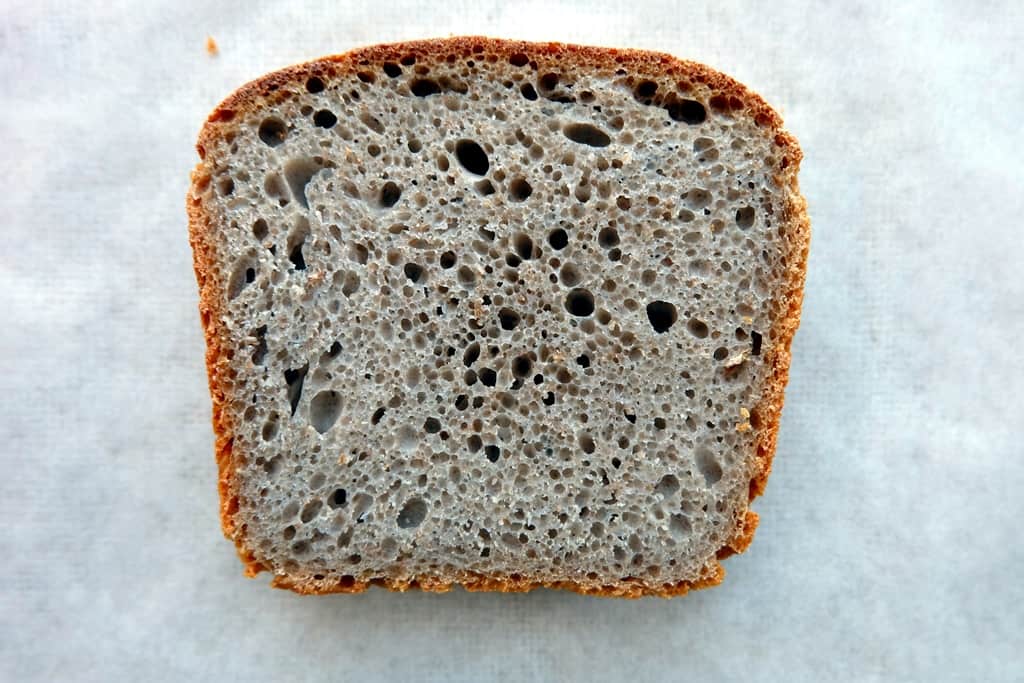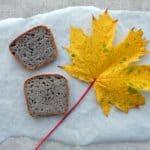Every autumn I see chestnut flour recipes popping up on my social media feeds. I love the hot floury taste of roasted chestnuts, sold by street vendors in Austrian Christmas markets. So this year, I finally decided to find out more about this seasonal flour and started to experiment with different chestnut flour recipes and also put together my own recipe for chestnut bread.

What is chestnut flour?
Chestnut flour is milled from dried and roasted sweet chestnuts. I’ve come across some lovely references for sweet chestnuts in my research including ‘nature’s little breads’ and ‘the grain that grows on trees’. I guess it’s a reflection of the significance sweet chestnuts had in some countries’ diets. These days, sweet chestnut trees can be found primarily in Italy and other smaller pockets across Southern Europe. Known as farina di castagne or farina dolce in Italy, chestnut flour is still considered a staple food particularly in and around Piedmont.
In their raw state sweet chestnuts taste bitter but when roasted and cooked they turn into soft, floury, tasty spuds. Chestnut flour is uniquely sweet, mellow and nutty. As chestnuts do not contain the fat content regular nuts have, and are instead largely composed of easily digestible carbohydrates, chestnut flour has many of the same properties as regular flour.
Where to buy chestnut flour UK / chestnut flour suppliers UK
Here are some chestnut flour suppliers which make the flour available in the UK:
- Shipton Mill chestnut flour – sourced directly from a small hill farmer, who gathers them from the hills in the Ardeche
- Amisa chestnut flour
How to make chestnut flour at home
- Making chestnut flour is easy but beware not to pick up horse chestnuts which are not edible! The chestnuts you need come from the sweet chestnut tree.
- If you have access to a flour mill, you can produce your own chestnut flour and if possible, grind the sweet flour with a stone mill. This is to preserve the flour’s natural flavouring and texture, ensuring there is no heat damage during processing in knife-based mills.
- Here’s how to prepare the chestnuts for milling. Remove the outer shell with a knife. Place the chestnut fruits into hot (not boiling) water. After a short while, the inner skin can be peeled of. Wash with cold water and dry. Grind into flour.
How to bake with chestnut flour
- Chestnut flour is gluten-free, making it a good cooking option for people with celiac disease or other gluten intolerances or allergies. However, for the same reason it can be a challenge to bake with.
- Use on its own or mixed with grain flour but beware that a 100% chestnut flour bake is likely to be quite dense and break up easily due to the lack of gluten.
- If a lot of chestnut flour is used, the flavour may be overwhelmingly sweet.
- For inspiration take a look at the chestnut flour recipes below.
- Chestnut flour breads have a pleasant smell and taste slightly sweet.
- It pairs well with ingredients such as almonds, chocolate, honey, and hazelnuts.
How to store chestnut flour
- You can store the chestnut flour in a tightly lidded plastic container.
- Alternatively, it can be stored in a sealed bag in the freezer and it will keep its floury texture without turning into a frozen brick.
Chestnut flour recipes & ideas
There is lots you can do with chestnuts and chestnut flour. Here are some delicious ideas of how to use chestnut flour in your kitchen. Hope you’ll find something suitable in this list of chestnut flour recipes for bread making, baking and pasta making.
- Castagnaccio – An ancient, rustic and unusual Tuscan delicacy; a type of Tuscan chestnut cake, like a dense, thick crêpe.
- Chestnut flour biscotti – twice baked biscuits, a chestnut-based version of Tuscan biscotti called cantuccini or these chestnut flour and chocolate drops biscotti
- Chestnut crêpes – simple recipe which can be filled with either savoury ingredients such as creamy mushrooms or served with a touch of sweetness, for example yoghurt and honey
- Dumplings made with chestnuts or chestnut flour are divine – try a recipe with pheasant stew or this Christmas version filled with dates, stewed apple and spices or this recipe for Austrian Maroniknödel
- Chestnut flour flatbreads or pancakes – beautiful Italian Necci pancakes are thin with crisp edges, made with just chestnut flour, water, salt and olive oil – eat plain or filled with sausage, pancetta or ricotta.
- Chestnut flour sourdough loaf – use a wheat sourdough starter and some chestnut flour as well as cooked chestnut chunks for this beautiful bread
- Blueberry & chestnut muffins – packed with frozen wild blueberries and lightly sweetened with brown rice syrup to enhance the natural sweetness of the chestnut flour
- Chestnut & chocolate scones – this recipe uses chestnut puree and chestnut flour; quick and comforting
- I found a great recipe for gluten free shortbread which uses chestnut, hazelnut and acorn flour.
- Chestnut flour tortillas – Paleo tortillas made with chestnut flour, tapioca flour, water, butter and salt.
- Gluten free chestnut flour waffles – A deliciously unique waffle which is light in texture but hearty in flavour.
- Make a quiche with this recipe for rainbow chard tart in a chestnut crust. The nuttiness is delightful with the savoury filling.
- Try this delicious chestnut pasta recipe for tagliatelle con farina di castagne, zucca e salsiccia
Chestnut flour bread recipe (sourdough)
Here is my own chestnut flour bread recipe, using 20% chestnut flour. I’ve also added some dark rye flour to add additional depth to the loaf. The chestnut flour flavours make this chestnut bread a delightfully autumnal treat.

Chestnut Bread Recipe
Ingredients
Chestnut sourdough ingredients
- 125 g rye sourdough starter
- 600 g strong white flour
- 150 g dark rye flour
- 150 g chestnut flour
- 600 g water
- 10 g salt
Instructions
How to bake chestnut flour bread
- Combine 125g rye sourdough starter, 150g strong white flour, 50g dark rye flour and 200g water. Mix well, cover and leave to rest at room temperature for 16 to 24 hours.
- Combine 400g of the sourdough (the rest of it goes back into the fridge for your next bake). Add 450g strong white flour, 100g dark rye flour, 150g chestnut flour, 10g salt and 400g water to form the dough.
- Knead for 10 minutes. The dough will be a bit sticky but don't be tempted to add more flour.
- Place the dough into a bowl, cover with a lid and rest at room temperature for 1 - 2 hours.
- Give the dough another quick knead, then place in a lightly buttered large baking tin (mine is 31 cm x 12.2 cm x 8.6 cm).
- Cover with a polythene bag and rest at room temperature for several hours until fully proved and significantly increased in size.
- Bake in a preheated oven at 220°C for 10 minutes, then at 200°C for a further 45 minutes.
- Cool on a wire rack.

